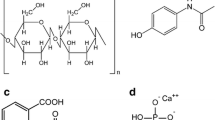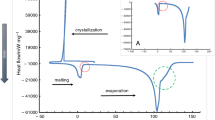Abstract
The amorphous forms of most active pharmaceutical substances are widely applied in solid dosage form technology because they are characterized by a better solubility and dissolution rate than their crystalline forms. With the amorphization of a crystalline active substance being the greatest challenge to be overcome in pharmaceutical technology, the aim of this study was to assess to what extent polymeric excipients such as cellulose derivatives affect the crystallinity of paracetamol, over-the-counter analgesic and antipyretic substance. To realize this purpose, binary physical mixtures containing 10, 30, 50, 70 and 90% of paracetamol were gently homogenized in a porcelain mortar with cellulose derivatives such as four kinds of hydroxypropyl methyl cellulose (HPMC) differing in their molecular masses and methylcellulose (MC). Differential scanning calorimetry (DSC) and spectroscopic techniques like Fourier transform infrared (FTIR) and Raman were applied as tools for evaluating the degree of paracetamol crystallinity reduction. The findings of these experiments revealed that cellulose derivatives do indeed reduce the degree of paracetamol crystallinity; however, the effect of the particular polymeric excipients did not show any statistically significant difference. Formation of metastable modification III of paracetamol was also confirmed, a modification which can be created in mixtures containing at least 10% of cellulose derivatives. In brief, all the HPMCs and MC examined affect the crystallinity of paracetamol to a similar degree. Furthermore, the degree of active substance crystallinity decreases as the content of cellulose derivatives in the mixture increases.








Similar content being viewed by others
References
Rowe RC, Sheskey PJ, Quinn ME. Handbook of pharmaceutical excipients. 6th ed. London: Pharmaceutical Press; 2009.
Marques-Marinho FD, Vianna-Soares CD. Cellulose and its derivatives use in the pharmaceutical compounding practice. In: Van De Ven TGM, editor. Cellulose—medical, pharmaceutical and electronic applications. London: Intechopen; 2013. p. 141–62. https://doi.org/10.5772/56637.
Patel R, Barker J, El Shaer A. Pharmaceutical excipients and drug metabolism: a mini-review. Int J Mol Sci. 2020;21:8224. https://doi.org/10.3390/ijms21218224.
Rashid R, Kim DW, Din FU, Mustapha O, Yousaf AM, Park JH, Kim JO, Yong CS, Choi HG. Effect of hydroxypropylcellulose and Tween 80 on physicochemical properties and bioavailability of ezetimibe-loaded solid dispersion. Carbohydr Polym. 2015;130:26–31. https://doi.org/10.1016/j.carbpol.2015.04.071.
Yan YD, Sung JH, Kim KK, Kim DW, Kim JO, Lee BJ, Yong CS, Choi HG. Novel valsartan-loaded solid dispersion with enhanced bioavailability and no crystalline changes. Int J Pharm. 2011;422:202–10. https://doi.org/10.1016/j.ijpharm.2011.10.053.
Xu W-J, Xie H-J, Cao Q-R, Shi L-L, Cao Y, Zhu X-Y, Cui J-H. Enhanced dissolution and oral bioavailability of valsartan solid dispersions prepared by a freeze-drying technique using hydrophilic polymers. Drug Deliv. 2016;23:41–8. https://doi.org/10.3109/10717544.2014.903012.
Negm AA, Furst DE. Nonsteroidal anti-inflammatory drugs, disease-modifying antirheumatic drugs, nonopioid analgesics & drugs used in gout. In: Katzung BG, editor. Basic & clinical pharmacology. 14th ed. Toronto: McGraw Hill; 2017.
Bernal V, Erto A, Giraldo L, Moreno-Piraján JC. Effect of solution pH on the adsorption of paracetamol on chemically modified activated carbons. Molecules. 2017;22:1032. https://doi.org/10.3390/molecules22071032.
European Medicines Agency. Paracetamol oral use, immediate release formulations product-specified bioequivalence guidance. London: Committee for Medicinal Products for Human Use; 2018. https://www.ema.europa.eu/en/documents/scientific-guideline/paracetamol-oral-use-immediate-release-formulations-product-specific-bioequivalence-guidance-first_en.pdf.
European Pharmacopoeia. 10th ed. Paris: Strasbourg Cedex; 2019. Monograph Paracetamol, p. 3481. https://pheur.edqm.eu/app/10-5/content/10-5/0049E.htm.
Gaisford S, Buanz ABM, Jethwa N. Characterisation of paracetamol form III with rapid-heating DSC. J Pharm Biomed Anal. 2010;53:366–70. https://doi.org/10.1016/j.jpba.2010.04.017.
Sibik J, Sargent MJ, Franklin M, Zeitler JA. Crystallization and phase changes in paracetamol from the amorphous solid to the liquid phase. Mol Pharm. 2014;11:1326–34. https://doi.org/10.1021/mp400768m.
Cruz PC, Rocha FA, Ferreira AM. Application of selective crystallization methods to isolate the metastable polymorphs of paracetamol: a review. Org Process Res Dev. 2019;23:2592–607. https://doi.org/10.1021/acs.oprd.9b00322.
Perrin MA, Neumann MA, Elmaleh H, Zaske L. Crystal structure determination of the elusive paracetamol Form III. Chem Commun. 2009;22:3181–3. https://doi.org/10.1039/b822882e.
Telford R, Seaton CC, Clout A, Buanz A, Gaisford S, Williams GR, Prior TJ, Okoye CH, Munshi T, Scowen IJ. Stabilisation of metastable polymorphs: the case of paracetamol form III. Chem Commun. 2016;52:12028–31. https://doi.org/10.1039/c6cc05006a.
Ogienko AG, Boldyreva EV, Manakov AY, Boldyrev VV, Yunoshev AS, Ogienko AA, Myz SA, Ancharov AI, Achkasov AF, Drebushchak TN. A new method of producing monoclinic paracetamol suitable for direct compression. Pharm Res. 2011;28:3116–27. https://doi.org/10.1007/s11095-011-0502-x.
Rams-Baron M, Jachowicz R, Boldyreva E, Zhou D, Jamroz W, Paluch M. Amorphous drugs. Benefits and challenges. Cham: Springer; 2018. https://doi.org/10.1007/978-3-319-72002-9.
Vasconcelos T, Sarmento B, Costa P. Solid dispersions as strategy to improve oral bioavailability of poor water soluble drugs. Drug Discov Today. 2007;12:1068–75. https://doi.org/10.1016/j.drudis.2007.09.005.
Schittny A, Huwyler J, Puchkov M. Mechanisms of increased bioavailability through amorphous solid dispersions: a review. Drug Deliv. 2020;27:110–27. https://doi.org/10.1080/10717544.2019.1704940.
Leyk E, Wesolowski M. Interactions between paracetamol and hypromellose in the solid state. Front Pharmacol. 2019;10:14. https://doi.org/10.3389/fphar.2019.00014.
Malviya R, Srivastava P, Bansal M, Sharma PK. Improvement of dissolution behavior of paracetamol using solid dispersion technique. Int J Pharm Sci Res. 2010;1:95–9. https://doi.org/10.13040/IJPSR.0975-8232.1(7).95-99.
Singh A, Sharma PK, Meher JG, Malviya R. Evaluation of enhancement of solubility of paracetamol by solid dispersion technique using different polymers concentration. Asian J Pharm Clin Res. 2011;4:117–9.
Laitinen R, Löbmann K, Strachan CJ, Grohganz H, Rades T. Emerging trends in the stabilization of amorphous drugs. Int J Pharm. 2013;453:65–79. https://doi.org/10.1016/j.ijpharm.2012.04.066.
Qi S, Avalle P, Saklatvala R, Craig DQM. An investigation into the effects of thermal history on the crystallisation behaviour of amorphous paracetamol. Eur J Pharm Biopharm. 2008;69:364–71. https://doi.org/10.1016/j.ejpb.2007.10.008.
Politov AA, Kostrovskii VG, Boldyrev VV. Conditions of preparation and crystallization of amorphous paracetamol. Rus J Phys Chem A. 2001;75:1903–11.
Shtukenberg AG, Tan M, Vogt-Maranto L, Chan EJ, Xu W, Yang J, Tuckerman ME, Hu CT, Kahr B. Melt crystallization for paracetamol polymorphism. Cryst Growth Des. 2019;19:4070–80. https://doi.org/10.1021/acs.cgd.9b00473.
Tombari E, Ferrari C, Johari GP, Shanker RM. Calorimetric relaxation in pharmaceutical molecular glasses and its utility in understanding their stability against crystallization. J Phys Chem B. 2008;112:10806–14. https://doi.org/10.1021/jp801794a.
Gunawan L, Johari GP, Shanker RM. Structural relaxation of acetaminophen glass. Pharm Res. 2006;23:967–79. https://doi.org/10.1007/s11095-006-9898-0.
Perlovich GL, Volkova TV, Bauer-Brandl A. Polymorphism of paracetamol. Relative stability of the monoclinic and orthorhombic phase revisited by sublimation and solution calorimetry. J Therm Anal Calorim. 2007;89:767–74. https://doi.org/10.1007/s10973-006-7922-6.
Boldyreva EV, Drebushchak VA, Paukov IE, Kovalevskaya YA, Drebushchak TN. DSC and adiabatic calorimetry study of the polymorphs of paracetamol. An old problem revisited. J Therm Anal Calorim. 2004;77:607–23. https://doi.org/10.1023/B:JTAN.0000038998.47606.27.
Martínez LM, Videa M, López-Silva GA, Reyes CA, Cruz-Angeles J, González N. Stabilization of amorphous paracetamol based systems using traditional and novel strategies. Int J Pharm. 2014;477:294–305. https://doi.org/10.1016/j.ijpharm.2014.10.021.
Mohammed H, Briscoe BJ, Pitt KG. A study on the coherence of compacted binary composites of microcrystalline cellulose and paracetamol. Eur J Pharm Biopharm. 2006;63:19–25. https://doi.org/10.1016/j.ejpb.2005.10.001.
Yu HCM, Rubinstein MH, Jackson IM, Elsabbagh HM. Multiple compression and plasto-elastic behaviour of paracetamol and microcrystalline cellulose mixtures. J Pharm Pharmacol. 1988;40:669–73. https://doi.org/10.1111/j.2042-7158.1988.tb06992.x.
Wahlberg N, Madsen AØ, Mikkelsen KV. Heterogeneous nucleation of polymorphs on polymer surfaces: polymer–molecule interactions using a Coulomb and van der Waals model. J Mol Model. 2018;24:155. https://doi.org/10.1007/s00894-018-3664-1.
Dichi E, Sghaier M, Guiblin N. Reinvestigation of the paracetamol-caffeine, aspirin-caffeine, and paracetamol-aspirin phase equilibria diagrams. J Therm Anal Calorim. 2018;131:2141–55. https://doi.org/10.1007/s10973-017-6855-6.
Caliandro R, Di Profio G, Nicolotti O. Multivariate analysis of quaternary carbamazepine-saccharin mixtures by X-ray diffraction and infrared spectroscopy. J Pharm Biomed Anal. 2013;78–79:269–79. https://doi.org/10.1016/j.jpba.2013.01.042.
Jendrzejewska I, Goryczka T, Pietrasik E, Klimontko J, Jampilek J. X-ray and thermal analysis of selected drugs containing acetaminophen. Molecules. 2020;25:5909. https://doi.org/10.3390/molecules25245909.
Klìmová K, Leitner J. DSC study and phase diagrams calculation of binary systems of paracetamol. Thermochim Acta. 2012;550:59–64. https://doi.org/10.1016/j.tca.2012.09.024.
Giordano F, Rossi A, Bettini R, Savioli A, Gazzaniga A, Novák C. Thermal behavior of paracetamol-polymeric excipients mixtures. J Therm Anal Calorim. 2002;68:575–90. https://doi.org/10.1023/A:1016004206043.
Burgina EB, Baltakhinov VP, Boldryeva EV, Shakhtschneider TP. IR spectra of paracetamol and phenacetin. J Struct Chem. 2004;45:64–73. https://doi.org/10.1023/B:JORY.0000041502.85584.d5.
Łuczak A, Jallo LJ, Dave RD, Iqbal Z. Polymorph stabilization in processed acetaminophen powders. Powder Technol. 2013;236:52–62. https://doi.org/10.1016/j.powtec.2012.05.046.
Zimmerman B, Baranović G. Thermal analysis of paracetamol polymorphs by FT-IR spectroscopies. J Pharm Biomed Anal. 2011;54:295–302. https://doi.org/10.1016/j.jpba.2010.08.023.
Łojewska J, Miśkowieca P, Łojewski T, Proniewicz LM. Cellulose oxidative and hydrolytic degradation: in situ FTIR approach. Polym Degrad Stab. 2005;88:512–20. https://doi.org/10.1016/j.polymdegradstab.2004.12.012.
Acknowledgements
This research was funded by the Ministry of Science and Higher Education, Poland, Grant Number 02-0015/07/505.
Author information
Authors and Affiliations
Contributions
EL helped in conceptualization, methodology, software, formal analysis, investigation, data curation, writing–original draft preparation, writing–review and editing. MW performed conceptualization, writing–original draft preparation, writing–review and editing, supervision. All authors have read and agreed to the published version of the manuscript.
Corresponding author
Additional information
Publisher's Note
Springer Nature remains neutral with regard to jurisdictional claims in published maps and institutional affiliations.
Rights and permissions
About this article
Cite this article
Leyk, E., Wesolowski, M. The effect of cellulose derivatives on paracetamol crystallinity reduction. J Therm Anal Calorim 147, 10037–10048 (2022). https://doi.org/10.1007/s10973-022-11312-9
Received:
Accepted:
Published:
Issue Date:
DOI: https://doi.org/10.1007/s10973-022-11312-9




